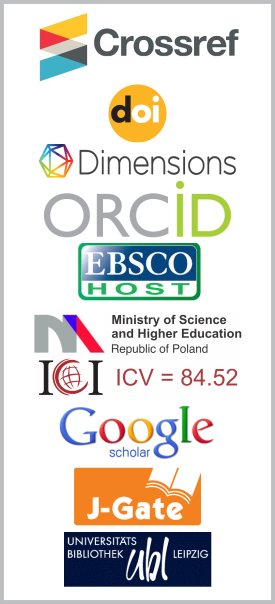Combined Effects of Magnetic Field and Slip Parameter on Hydromagnetic Flow Through Porous Media With Different Slip Velocities at Both the Porous Interface
DOI:
https://doi.org/10.26713/jims.v10i3.788Keywords:
Magnetic field, Porous media, Different slip velocities and BJ slip conditionAbstract
Effects of magnetic field and slip parameter on hydromagnetic flow through a uniform channel covered by porous media with different slip velocities at both the porous interface have been investigated. In the direction perpendicular to the motion of the fluid, a uniform magnetic field is applied. The analytical solution for the equations governing to the problem is obtained by using the Beavers-Joseph slip condition. Slip velocities at both the porous interface are assumed to be different. The flow characteristics such as axial velocity, slip velocity and the shear stress are calculated for different values of Hartmann number, porous parameter and slip parameter. It is observed that due to slip velocity variation in both the upper and lower walls, the distribution of flow pattern have altered.Downloads
References
M.S. Abuzaytoon and M.H. Hamdan, A note on the beavers and Joseph condition for flow over a Forchheimer porous layer, International Journal of Research in Engineering and Science 5(3) (2017), 13 – 20.
M.S. Abuzaytoon, T.L. Alderson and M.H. Hamdan, Flow over a Darcy porous layer of variable permeability, Journal of Applied Mathematics and Physics 14 (2016), 86 – 99, DOI: 10.4236/jamp.2016.41013.
S.O. Alharbi, T.L. Alderson and M.H. Hamdan, Exact solution of fluid flow through porous media with variable permeability for a given vorticity distribution International Journal of Enhanced Research in Science, Technology and Engineering 5(5) (2016), 262 – 276.
G.S. Beavers and D.D. Joseph, Boundary conditions at a naturally permeable wall, J. Fluid Mech. 30 (Part-I) (1967), 197 – 207, DOI: 10.1017/s002211206.
V. Ciriello, V. Di Federico, R. Archetti and S. Longo, Effect of variable permeability on the propagation of thin gravity currents in porous media, International Journal of Non-Linear Mechanics 57 (2013), 168 – 175, DOI: 10.1016/j.ijrnonlinmec2013.07.003.
P.K. Gaur, A.K. Jha and R. Sharma, Magneto-Polar fluid flow through a Porous medium of variable permeability in slip flow regime, Int. J. Applied Mechanics and Engineering 21(2) (2016), 323 – 339, DOI: 10.1515/ijame-2016.0020.
M.H. Hamdan and M.T. Kamel, Flow through variable permeability porous layers, Adv. Theor. Appl. Mech. 4(3) (2011), 135 – 145.
J.S. Hansen, B.D. Todd and P.J. Daivis, Prediction of fluid velocity slip at solid surfaces, Physical Review E 84 (2011), 1 – 8, DOI: 10.1103/PhysRevE.84.016313.
R.S. Harjeet Kumar, C.S. Kumar and S. Kumar, A mathematical model for different shapes of stenosis and slip velocity at the wall through mild stenosis artery, Advances in Applied Mathematical Bio Sciences 5(1) (2014), 9 – 18.
M. Lebars and M.G. Worster, Interfacial conditions between a pure fluid and a porous medium: implications for binary alloy solidification, J. Fluid Mech. 550 (2006), 149 – 173, DOI: 10.1017/s0022/12005007998.
O.D. Makinde and E. Osalusi, MHD flow in a channel with slip at the permeable boundaries, Rom. J. Phys. 51(3) (2006), 319 – 328.
A. Mikelic, On the effect boundary conditions between different flow regions, Proceedings of first Conference on Applied Mathematics and Computation, Dubrovnik, Croatia, September 13-18, pp. 21-37 (1999).
G. Neale and W. Nader, Practical significance of Brinkman's extension of Darcy's law: coupled parallel flows within a channel and a bounding porous medium, The Can. J. Chem. Eng. 52 (1974), 475 – 478, DOI: 10.1002/cjce.5450520407.
K. Ramakrishnan and K. Shailendhra, Hydromagnetic flow through uniform channel bounded by porous media, Appl. Math. Mech.-Engl. Ed. 32(7) (2011), 837 – 846, DOI: 10.1007/s/0483-011-1463-7.
P.S. Rao and S. Agarwal, Effect of permeability and different slip velocities at both the porous interface using couple stress fluids on the slider bearing load carrying mechanism, Proceedings of the institution of Mechanical Engineers, Part J: Journal of Engineering Tribology 230(2) (2016), 196 – 201, DOI: 10.1177/1350650115595054.
J.-J. Shu, J.B.M. Teo and W.K. Chan, Fluid velocity slip and temperature jump at a solid surface, Applied Mechanics Reviews 69(2) (2017), 1 – 32, DOI: 10.1115/1.4036191.
M. Stastna, G. Tenti, S. Sivaloganathan and J.M. Drake, Brain bio mechanics: consolidation theory of hydrocephalus variable permeability and transient effects, Canadian Applied Mathematics Quarterly 7(1) (1999), 93 – 109.
K. Vafai, Fluid mechanics of the interface region between a porous medium and a fluid layer - An exact solution, Int. J. Heat Fluid Flow 11(3) (1990), 254 – 256, DOI: 10.1016/0142-727X(90)90045-D.
M.A.M. Van Lankveld, Validation of boundary conditions between a porous medium and a viscous fluid, Report No. WFW 91.071, August 1991, Eindhoven University of Technology.
B.H. Venna, Effect of velocity slip and permeability on Micro polar squeeze films, International Journal of Computer and Mathematical Sciences 3(4) (2014), 41 – 50.
N.K. Verma, S. Mishra, S.U. Siddiqui and R.S. Gupta, Effect of slip velocity on blood flow through a catheterized artery, Applied Mathematics 2 (2011), 764 – 770, DOI: 10.4236/am.2011.26102.
L. Zhao, C. Marchioli and H.I. Andersson, Slip velocity of rigid fibers in turbulent channel flow, Physics of Fluids 26 (2014), 1 – 26, DOI: 10.1063/1.4881942.
Downloads
Published
How to Cite
Issue
Section
License
Authors who publish with this journal agree to the following terms:- Authors retain copyright and grant the journal right of first publication with the work simultaneously licensed under a CCAL that allows others to share the work with an acknowledgement of the work's authorship and initial publication in this journal.
- Authors are able to enter into separate, additional contractual arrangements for the non-exclusive distribution of the journal's published version of the work (e.g., post it to an institutional repository or publish it in a book), with an acknowledgement of its initial publication in this journal.
- Authors are permitted and encouraged to post their work online (e.g., in institutional repositories or on their website) prior to and during the submission process, as it can lead to productive exchanges, as well as earlier and greater citation of published work.




